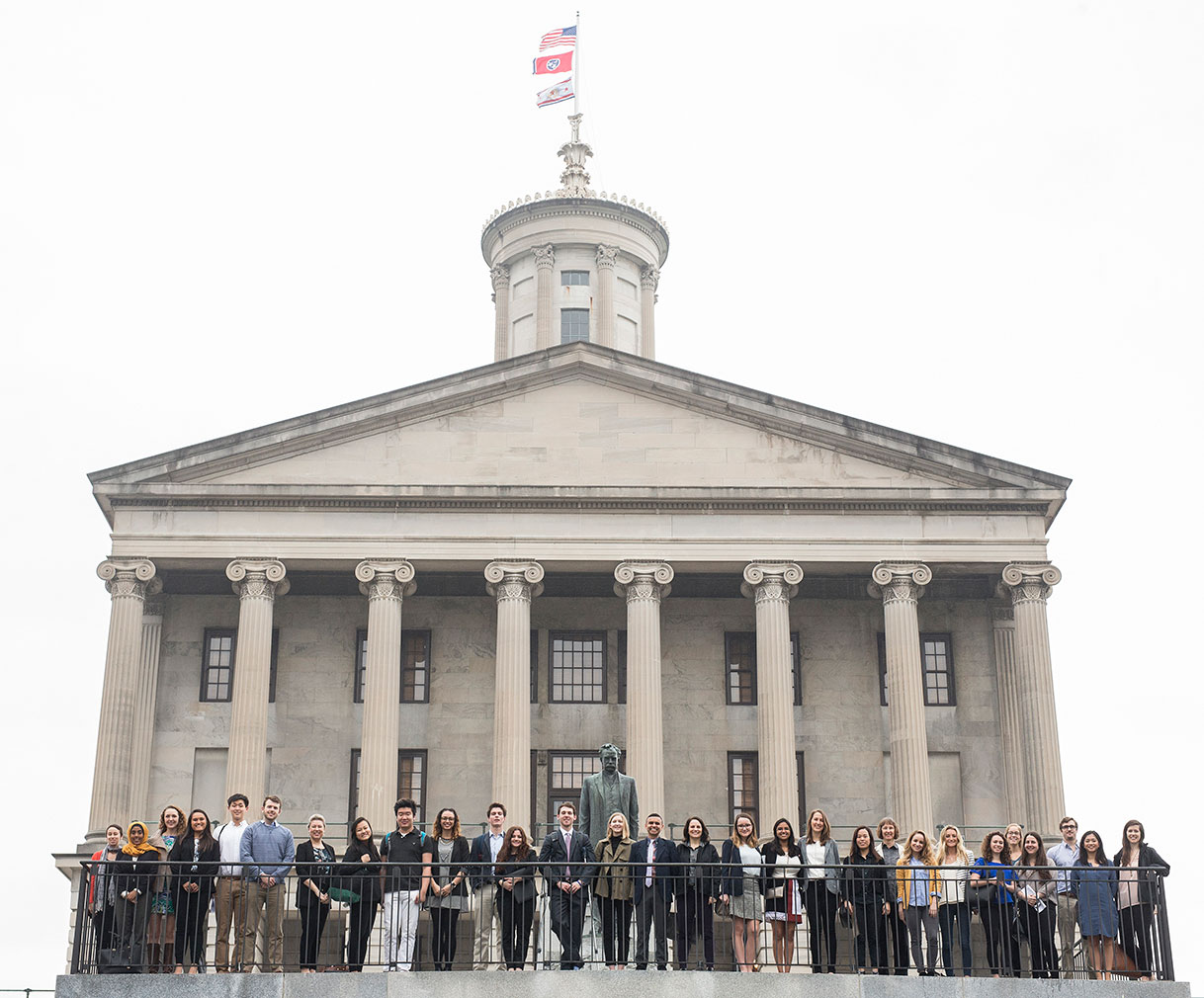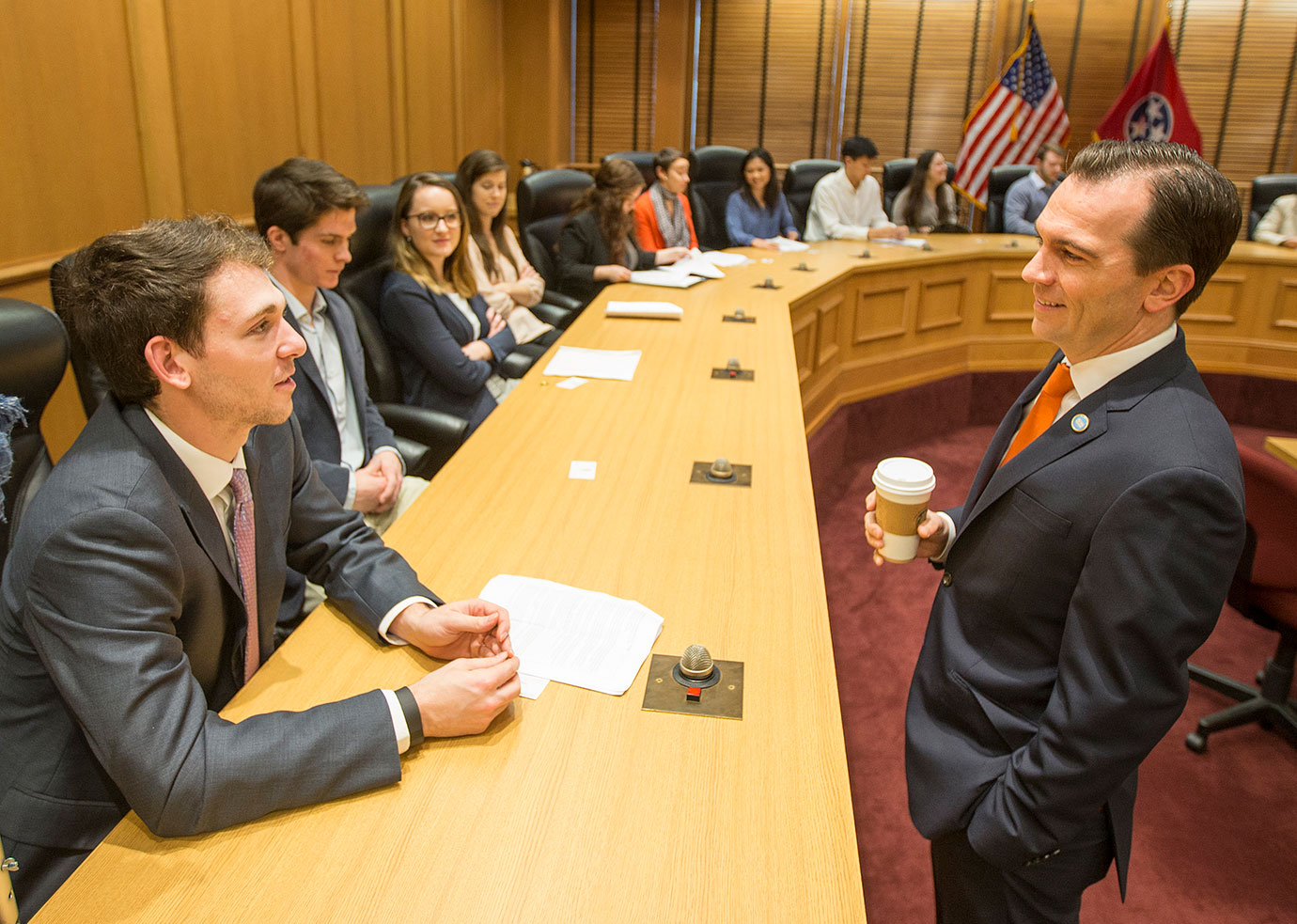Home » News » Tennessee State Capitol Visit Reflection #2
Tennessee State Capitol Visit Reflection #2
Posted by anderc8 on Monday, April 3, 2017 in News, The Nation's Health.

Members of the “The Nation’s Health” University Course pose before the Tennessee State Capitol during their recent day on the hill.
Written by Courtney Black
When our class visited the Tennessee State Capitol, we were fortunate enough to get an insider’s view by sitting in on a committee meeting, meeting with a state senator and hearing about the activities of staff members. My group met with Senator Richard Briggs, and I found his insight particularly interesting because of his connections between personal background and policy opinion since he is also a doctor. By having such experience and playing an active role in the medical industry, Sen. Briggs can identify how legislation may impact such industry “insiders” as opposed to other legislators. While meeting, I thought about how his position relates to the conversation we had about Tom Price’s appointment to the HHS because of his medical experience. I also found Sen. Briggs memorable because of his elaboration on comparative health insurance models across nations, which is one area of his interest due to his time spent living in France. He likes the French model, and he stated that a source of the current U.S. challenge is that we allow multiple models as opposed to one. It was easy to apply class concepts to his message and see how they factor into policy considerations, such as the spectrum of public – private combinations of healthcare and insurance models. Additionally, I have taken a healthcare economics elective, which covered models in different countries. As a result, both courses were brought together with real world applicability. The final reason why Sen. Briggs’ conversation stuck out was that he values the consideration of students. He received material from students on smoking on college campuses, which was used for a smoking bill proposal. His openness indicated that our class exercises, like policy briefs, can leave a lasting impact on those interested.

Rep. John Ray Clemmons greets students during their visit to Capitol Hill.
When walking between meetings, I was the most surprised by the environment. I knew it was going to be busy since the House and Senate were in session, but I did not expect it to be as fast-paced as it was. While walking the hallways, current events were a focus: there were TVs throughout showing the news, and I saw individuals waiting for their meetings reading the newspaper. I was also surprised to see the lobbyists. While we had talked about their role, I was unsure of how they would interact with the legislators on a daily basis. They were mostly set up in the hallways with tables and banners highlighting their issue of interest, and to me, their presence added to the physical busyness and numerous issues with which legislators dedicate attention to in a day.
While touring the Capitol, the House of Representatives and its related history were most exciting. While I usually don’t react to fun facts, I found the story about Tennessee as the 36th state to ratify the 19th amendment, following a one-vote margin in the House, a unique narrative in our state making a national difference. During the tour, we also learned about the legislature being part-time, which related to our class discussion on legislative professionalism. Our tour guide mentioned this allows legislators to live with their constituents the rest of the year, but I was still left wondering about their lifestyles and managing a two-career position.
The last portion of our visit included meeting with two staff members to learn about their day-to-day assignments. While research, creating talking points, answering constituents and administrative work were tasks mentioned by both staffers, they mentioned that each legislator has his/her own approach. I thought it was fascinating how these staff members didn’t have training – this fragmented style works best to just dive in. While I see the benefits to a system operating to meet the legislator’s needs and preferences, I wondered if there would be any time saved and benefits to efficiency through standardization. Additionally, each state varies with staff structure. One of our guests had worked in Tennessee and Hawaii; I was surprised to learn that in Hawaii, a full staff team worked to do the job he alone was performing in Tennessee. I would be curious to learn if state history or other factors influence the set-up of such structures. I found it to be rewarding to hear from both legislators and their staff, see the environment and learn about our state’s history within one morning.
